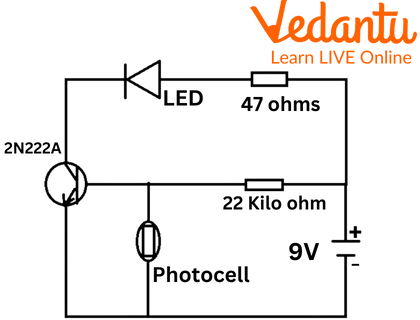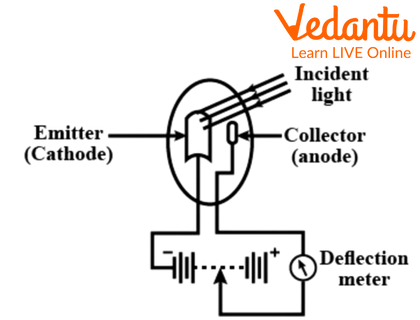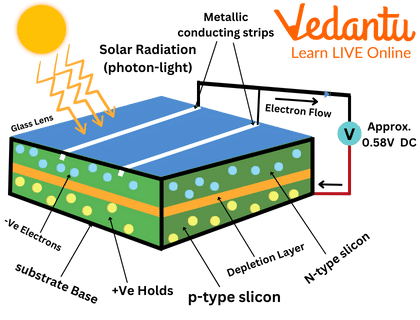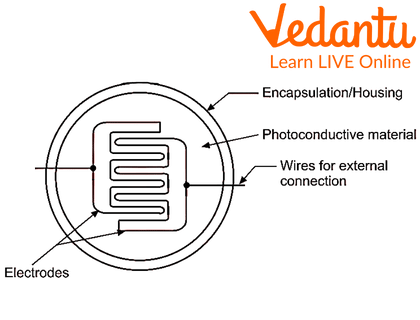




An Overview of Photocells
Photocells is an umbrella term for different types of photoelectric cells which mainly use the light energy or radiation emitted by the sun, absorb it and convert it into electrical energy. Their main work is based on a phenomenon known as photo electric effect, in which a light sensitive material absorbs light energy or photons and emits an electron thus generating electricity. These are used in various electrical devices. We will discuss these photocells, their types, significance, and uses in this article.

Circuit Diagram of Photocell
Types of Photocell
There are mainly three types of Photocell which are discussed in this section.
The Photoemissive Cell
The term photoemissive means a material which can emit electrons when energy in certain forms like radiation is supplied to the material. When the energy is provided to the material, the electrons in the material get excited and are thus emitted out of their original orbits.
A photoemissive cell is more commonly known as a Phototube. It is based on the photoelectric effect, which is a phenomenon which includes light energy bombarded on any light sensitive material which then emits out electrons.

A Photoemissive Cell
The Photovoltaic Cell
A Photovoltaic cell also simply known as a Solar Cell. It is an electronic device which converts the solar energy falling on it into electricity. This is known as the photovoltaic effect which is essentially a physical and chemical phenomenon.

A Photovoltaic Cell
The Photoconductive Cell
It is an electrical device which is light sensitive and works as a resistor. The resistance decreases with an increase in the light intensity.

A Photoconductive Cell
What is the Importance of a Photocell?
In this section, we will talk about the significance of photocell. Photocells, nowadays, are being used in a lot of electrical appliances, which makes their use more eco-friendly since all type of photocells are majorly based on the photoelectric effect which takes energy mainly from the Sun, thus producing close to no pollution and even though it involves high initial investment but in later stages, it is very cost-effective.
Uses of Photocell
Some applications of photo electric cells are mentioned below.
They are used in various devices such as:
Sensors
Automatic Lights
Calculators
Lux Metres which is used to detect light intensity.
Switches
Robotics
Burglar Alarms
They are also used in sound reproduction while recording films, etc.
Sample Questions
State whether the statements mentioned below are true or not.
1. Photovoltaic cells and solar cells are the same thing.
Ans: True.
2. Photocells are an eco-friendly option.
Ans: True.
3. Does photocell cause pollution?
Ans: No, photocells do not cause any pollution because they mainly utilise sunlight and convert it into electrical energy.
Complete the following statements by filling in the blanks.
1. There are ______ types of photocells.
Ans: three.
2. Photocells mainly function based on ________
Ans: photoelectric effect.
3. Photoelectric effect most commonly uses _______ energy.
Ans: light
Summary
There are three types of photocells, Photoemissive, Photovoltaic, and Photoconductive. They are mainly based on the photoelectric effect, which is when energy in any form is supplied to a sensitive material, the material emits an electron, the energy can be in the form of light, heat, etc. and the target material will be respective to the form of energy. Photocells are usually used in a lot of electronics. They are eco-friendly and cause no pollution.
FAQs on Photochemical Cell
1. Which material is used to form a photocell?
The material which is most commonly used to make photocells is Cesium (Cs), it is a metal. Other than that there are other elements which can be used to make photocells, such as Silicon, Germanium, etc.
2. What radiation of light is used in photoelectric effect?
There is a range of light radiations starting from microwaves, based on the frequency and wavelength of the light waves. For photoelectric effect to take place, light of specific wavelength and frequency are required. These light radiations usually lie in the visible region of the spectrum, having the wavelength ranging from 400 nm to 700 nm.
3. Is electricity required for working on a photocell?
No, a photocell does not essentially require electricity, it requires light energy which it absorbs and converts into electrical energy. That is the main purpose of a photocell, thus we can conclude that it does not require electricity but is used to generate electricity.









